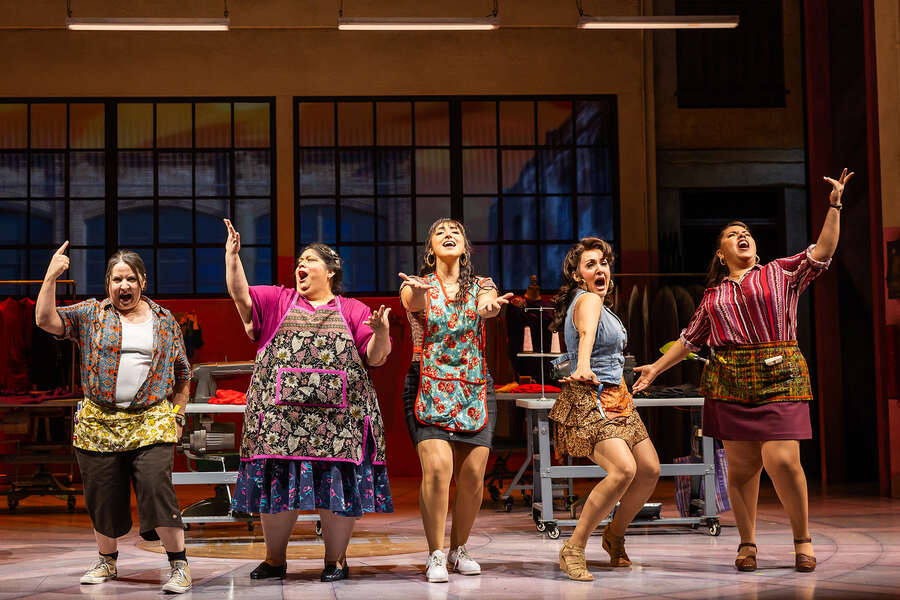My abuela had a flair for the dramatic and a lot of womanly advice. She shared that advice freely while watching over a frying pan, brushing off the occasional splash of hot oil with a loud curse. It poured forth in the form of epic novellas with winding side plots about the women in our family. It held a magical, almost spiritual quality; in the sanctity of her kitchen, it was shared as a roadmap for living under patriarchy. As a teenager, after visits to her house in Inglewood, Calif., I would furiously type her stories into the Notes app on my phone, and later turn them into poetry.
Decades earlier and a few miles to the north and east, in Boyle Heights, teenage Josefina López ritually listened to her sister, mother, and their friends exchange laughter as they sewed dresses in the factory where they worked. Some days the tiny factory got so hot that López had to iron in her underwear just to stay cool, but still, she looked forward to being there, among the stories and the full-bodied cackles they provoked. For an undocumented girl, the echo of this laughter in the sacred circle of sewing women was the first place she felt a true sense of belonging. She’d rush to the bathroom between ironing and jot the stories down in her diary.
In 1988, when López was just 18, she crafted those diary entries into Real Women Have Curves, a play about her and the immigrant women who sewed and laughed alongside her. It premiered in 1990 at the Mission Cultural Center in San Francisco, Calif., and, in the 33 years since, has been produced more than 130 times at theatres across the country. In 2002, the play was adapted into an award-winning film, starring America Ferrera, for which López co-wrote the screenplay with George LaVoo.
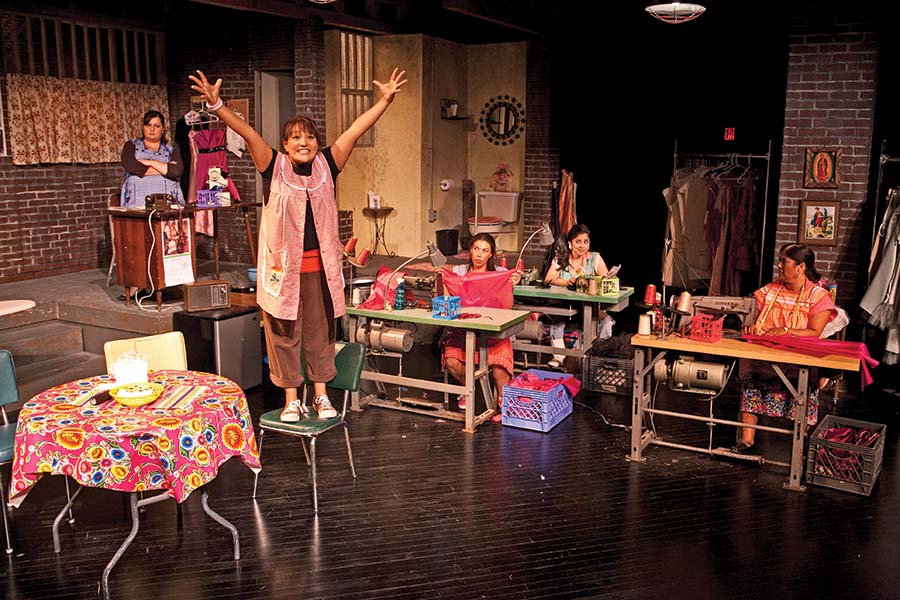
Recently the story was reincarnated as a musical at American Repertory Theater in Cambridge, Mass. Real Women Have Curves, the musical, based on López’s play and movie, follows 18-year-old Ana as she longs to go to college at Columbia University, while her mother, Carmen, wants her to stay and work at the family sewing factory. With a book by Lisa Loomer, music and lyrics by Joy Huerta and Benjamin Velez, and direction and choreography by Sergio Trujillo, the musical was in development for about three years before it hit the stage in Cambridge last December (it closed this past Sunday, Jan. 21). Its producers already have their sights set on Broadway.
This represents an exciting possibility. It’s no secret that the mainstream theatre landscape lacks stories exploring the criminalization of immigrants, intersectional feminism, and economic oppression. As a theatre lover and Mexican woman from California who, like Ana, left home for New York City, it’s a sentimental prospect, and one I’m ready to celebrate. At the same time, I’m apprehensive. I crave new stories about this subject matter and yearn for the development of work by emerging Mexican artists. So the notion of a musical based on a movie based on a play from 1988, with a script rewritten decades later by writers who don’t share the lived experiences of the show’s creator, set me a little on edge. Before I even stepped into the theatre, my feelings were complicated. They were further complicated after I saw the two-and-a-half-hour musical last month.
López, a seasoned playwright, producer, and founding artistic director of CASA 0101 Theater, wrote the original play to honor herself and the other women of the sewing factory, who taught her the value of womanhood. At first, she felt sorry for herself, when, at 18, instead of going off to an Ivy League University, like many of her high school peers, she had to spend her days ironing. But the hot little factory, she soon came to realize, was more than that. It was a cultural center. It was a space for storytelling, artistic production, and a kind of feminist education she couldn’t have gotten at Harvard or Yale.
“When I got to see the value of being a woman for the first time, I really wanted to celebrate that, document my life’s experience, and affirm the value of my life,” she told me in an interview.
As I consider the charge for López’s original story, I ponder the function of adaptation, and how to fairly evaluate and analyze it. Would the new musical version also aim to honor these women, the full spectrum of their humanity, and the value of their lives? Can it, if it’s written by someone else?
When book writer Lisa Loomer was brought onto the project by director Sergio Trujillo, she was immediately inspired, she told me, by what she feels to be the central questions of López’s story: “What do we owe ourselves? What do we owe our families and our cultures?” These questions guided her writing as she added characters and subplots around immigration politics and assimilation, what she called “new emphases for a new time.” She added, “It speaks to the brilliance of what [López] did that it can be reimagined, almost like a myth.”

Though Loomer’s parents have lived in Mexico for 50 years and she partly grew up there, she is not of Mexican descent, nor has she ever been undocumented. What does it mean for her, then, to rewrite a story originally by and about an undocumented Mexican girl?
“My family’s background is Spanish, Romanian, and Sephardic, although I prefer not to really talk about myself that much in articles,” she said. “Certainly, Mexico is all through this project. You have to know Mexico in order to talk about Mexicans.”
Loomer, whose plays include Roe, Living Out, and The Waiting Room, feels a personal connection to López’s play and movie, as Loomer tends to explore women’s voices and bodies in her work.
“Some of my experience does not parallel Ana’s, but that central question—of what we owe others versus what we owe ourselves, if we’re going to fully realize what we’re meant to do and who we’re meant to be in the world—is something that strikes a big chord for me,” Loomer said.
The show struck some chords with me too. Though still a work in progress, the musical proves an ideal format to celebrate the humor, desire, and joy of the women at its heart. There’s something powerful about watching a group of immigrant women of color loudly and boldly take up space, dancing and singing about everything from their enduring bodies to their wisdom about resisting patriarchy. A song titled “Adios Andres,” about Ana’s mother’s entrance into menopause, is a hilarious, warm-hearted romp that reminded me of conversations with my grandmother, mother, and sister about the trials and pleasures of womanhood. It’s not often I see intimate moments like these rendered onstage so joyously.
“White people might have all the money and all the power, but we have all this creativity and all this resiliency, and we’re having all the fun,” López told me of her time in the sewing factory.
In the musical, the factory women certainly have fun. And it was fun watching them.
It’s the not-so-fun parts that gave me pause. At times, I felt that the musical shrinks complex dynamics into trite dialogue and catchy tunes, and falls back on oversimplified tropes. The nuances of immigration status, intergenerational trauma, and feminist politics—as they manifest in the lives of resolute, imperfect women—are too often flattened. Perhaps unfairly, I found it difficult to swallow a sanitized version of López’s story, when the realities upon which it is based are so rich, dynamic, and beautiful, and hardly ever depicted in mainstream musical theatre.
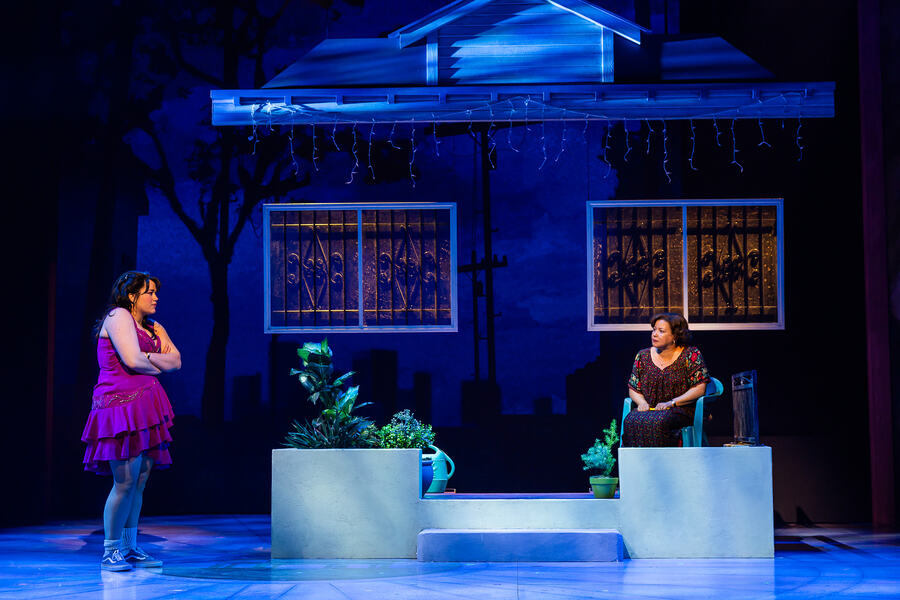
The musical’s central dynamic is the fraught, tense relationship between 18-year-old big dreamer Ana and Carmen, her cynical, overworked mother. Ana wants to go to college, but Carmen doesn’t approve, instead hoping to keep Ana in Boyle Heights, working in the family sewing factory.
In the musical, the first solo Carmen belts (“Blood Thicker Than Mole”) is a stern warning: “You dream of college and of writing for a paper? / Well, mija, put those dreams on hold and start doing as you’re told.” Throughout the musical, Carmen repeats that Ana’s dreams are unrealistic and unworthy of pursuing. She says, essentially: I have worked since I was a teenager and you will too. She’s afraid of Ana moving away. She’s resentful that Ana has options beyond labor in the factory. She’s bitter, but—spoiler alert—eventually becomes less so, allowing her daughter to reach her full potential.
For me, this central mother-daughter relationship only hovers on the surface through most of the show. In a few stronger moments, it cracks to reveal glimpses of the complex, contradictory matrix of emotion that could prevent a mom like Carmen from embracing her child’s dream. But they’re just that: glimpses. Indeed, the musical sets up dynamics that could give depth and color to its central relationship, then sets them aside without exploring them. For instance, the musical suggests Carmen’s anxiety about having loved ones out of reach—a torment pervasive among displaced families—without unpacking it. It hints at Carmen’s own unrealized dreams, but doesn’t excavate them. One gets the sense that Carmen yearns for Ana to recognize the knowledge that Carmen holds that could never be taught at an Ivy League university—especially given that such institutions were built on the bones of the oppressed—but again, this isn’t really delved into.
Another implied tension in the musical is Carmen’s fear that her daughter, like the forces that oppress her, might see her merely as a workhorse rather than a full person. Unlike in the film, where these tensions are expressed in dialogue (Carmen: “You’re ashamed of me? You’re ashamed to work with us? You think I’m a dog. No good for anything but work.” Later, Ana: “You’re all cheap labor for Bloomingdale’s!”), in the musical, these subtleties make it briefly into a song lyric, then are dropped in favor of neat resolutions.
I found myself wishing the musical had more moments rendering the layered messiness of Ana’s relationship with her mother, embracing the complexity and full humanity of them both. If, as the show develops, the musical’s writers could find more space for Ana and Carmen’s relationship to breathe, the characters might feel more real, whole, and lived in.
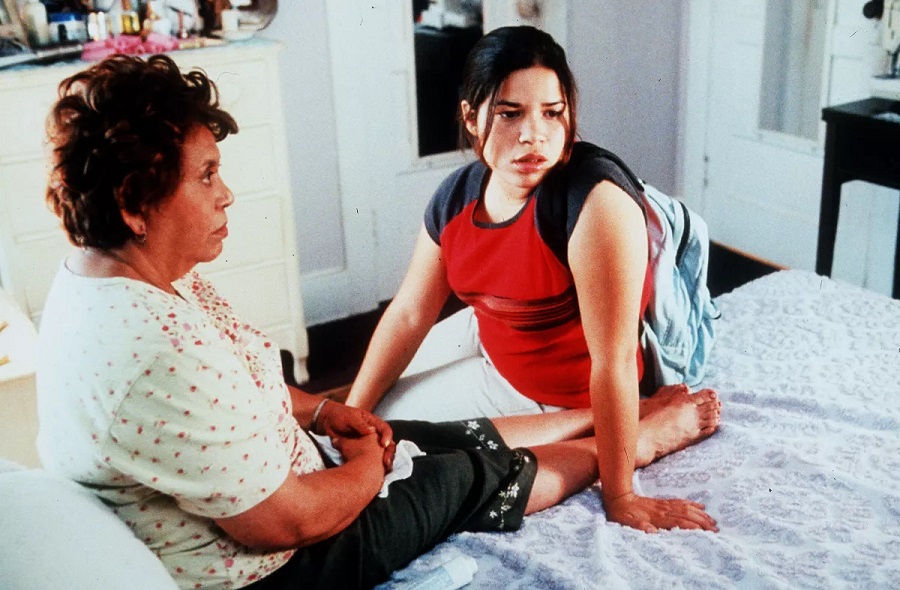
Unlike the film’s Ana, who is grounded, brooding, and full of angst, the musical’s Ana is a doe-eyed dreamer, naïve and spirited, with self-esteem and sense of hope that seem entirely unimpeded by her mother’s limited view of her possibilities. Admittedly, in many moments, this Ana is undeniably lovable. Her fierce belief in her own dreams and those of others is inspiring. López herself told me she welcomes this distinct approach to Ana. Her story, she believes, belongs to many women.
“I wrote it about my life at 18, and I had a limited scope of what I could write because that was my experience,” she said. “I’m not precious about, ‘It has to be this way,’ because ultimately it’s about the power of the message and the power of the truth.”
Meanwhile, the musical’s Carmen has two central truths: She works a lot and sacrifices a lot. I worry that by not fully coloring Carmen in, and not affording her a chance to assert that she’s good for more than work, the musical does the very thing it seems to want to combat: It reduces her character to her labor and sacrifice. In a sense, Carmen becomes Ana’s limited view of her. It reminds me of something López said to me about her own mother, on whom the Carmen of her play and movie was based.
“At home, I always thought she was a doormat, and my dad had all the power,” she recalled. “When I got into the factory, I saw how all the women respected my mother and how my mother was so funny, and my mother was such a great seamstress. I really got to see my mother in a new light. I thought, ‘Wow, my mother is a Third World feminist, I just didn’t know it.’”
That resonates with me. Perhaps it’s an unfair burden to place on this particular adaptation of this singular story, but in general, I can’t help but want more from stories about our (relationships with our) mothers. I want them to be layered, complicated, and compelling. I want these women to be defined in terms other than children, husbands, labor, and sacrifice. I want them to get to have desire, pleasure, insecurity. Not only because our mothers are much more than what they had to do to give their children and husbands the lives they have, but because rendering them as such makes for richer, deeper, more captivating human stories.
Both the play and movie end in a complicated jumble of hope, sorrow, and pain. Ana heads off to New York without her mother’s blessing. Close-up shots of Carmen show anguish, brokenness, and longing, and then the film fades to black on a final shot of Ana, strutting with confidence through Times Square. Between Carmen and Ana there is so much unresolved pain.
The musical ends more heartwarmingly, with Carmen giving Ana her blessing. It wraps a wholesome bow on Ana’s story, allowing for a celebratory curtain call and a satisfied walk out of the theatre. There’s a certain power in giving a girl like Ana the happy ending she fights for, onstage, in song, for all to bop along to. But at what cost? Is it worth papering over the hurt and complexity of Ana and Carmen’s relationship? Is it worth patching up Carmen’s wounds before we understand exactly how deep they are, how they came to be, and what they might need to heal? In this version, does Carmen exist only to serve Ana’s arc?
Then again, is a conclusion like this necessarily a bad thing for a musical? The happy ending seems, in part, to be Loomer’s attempt to stay true to the mandates of musical comedy, as Real Women Have Curves is her first venture into the form.
“It was a group decision,” she said. “People who had more experience and more wisdom about the form than I do felt strongly that it should have a positive ending. I am all for presenting a positive ending to young Latina women.”
It was also important to Loomer that Carmen have a change of heart. “I don’t think it is positive in a light-hearted or easily won or saccharine way,” she said. “I am happy with that ending. Because why don’t people get to grow and change?”
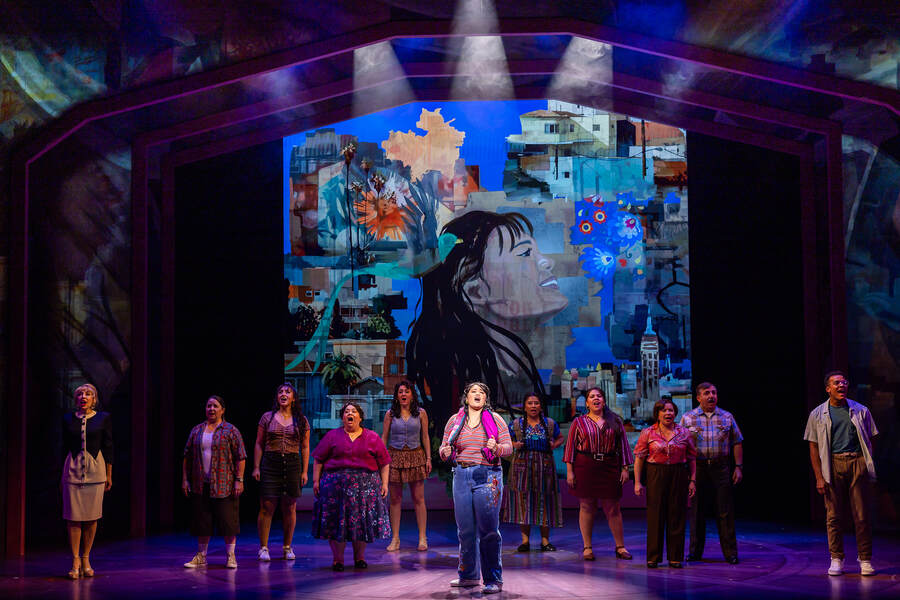
Injecting fresh relevance, while also introducing more complications, the musical fleshes out the original’s immigration story. This is obviously a highly embattled issue in the U.S. today, as it was in 1987, the year in which Real Women takes place. In particular, Guatemalan and Salvadoran characters have been added, in reference to the tense politics of the 1980s, when U.S.-funded dictatorships, wars, and death squads in Central America caused violence and poverty, from which refugees fled in unprecedented numbers to L.A. In 1986, President Reagan’s Immigration Control and Reform Act allowed certain undocumented immigrants to apply for legal status after paying a fine, learning to speak English, and demonstrating “a good moral character.” Indeed, López herself gained legal status after the act was signed into law.
In its efforts at “control,” though, the act also criminalized employers who hired undocumented workers, which led to increased workplace raids by Immigration Naturalization Services (INS) and the seizure, arrest, and deportation of many undocumented immigrants. In Boyle Heights in particular, a largely Latiné immigrant neighborhood in East L.A., INS raids were a constant threat to undocumented families. This time of anti-immigrant sentiment in the city and nationwide is the backdrop for the new Real Women Have Curves.
“When you look at the past, at times you can see the present even more painfully,” Loomer said. “The fact that our immigration system has been broken for that long—you realize, oh my God, it’s 2023 and it still hasn’t changed. And then that’s a question for our right now.”
It’s a worthy subject to tackle onstage, but as with the family story, the musical has trouble making space for all the personal and political dynamics the immigration storyline introduces. A heavy-handed bird metaphor and an upbeat group number about running from “la migra” reduce the experiences of undocumented immigrants in the U.S. to a dichotomy between the frantic state of hiding from the law and the transcendent state of flying above it all. What about everything in between?
Loomer has added a 17-year-old Indigenous Guatemalan refugee to the factory’s cast of women. Izel is quiet, sweet, and vulnerable, but full of hope. Ultimately, she is detained and deported, but not before singing “If I Were a Bird,” a warmhearted song about soaring above her challenging circumstances.
For her part, López celebrates the addition of Izel to her original story.
“Now that we have a writer outside of me who can look at the story and go back to ’87, we can add the whole experience of the Guatemalan and Salvadoran refugees,” López told me. “It became a bigger story through the musical.”
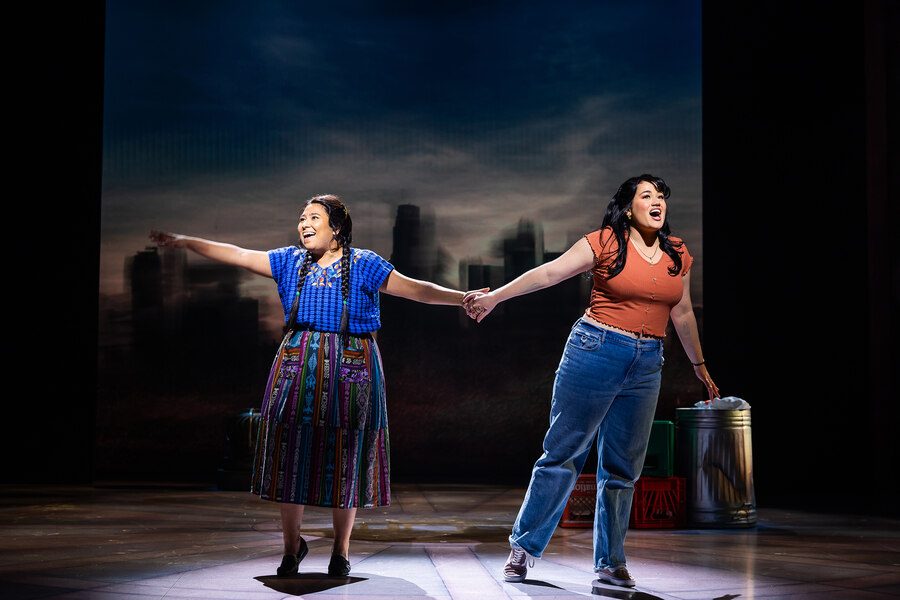
It is Izel’s incarceration that spurs Ana to a fiery resistance against the systems that oppress the people she loves. At first, after unsuccessfully trying to get Izel released from detention, Ana feels powerless. But after talking to the factory women, she realizes their (and her) strength. The messaging is self-contradictory, though, because Izel’s character herself isn’t afforded agency. We don’t learn about her fears (beyond detention and deportation), or her desires, hopes, and dreams (beyond avoiding detention and deportation). Her character lacks specificity, seeming to be a stand-in for a category of person who would have been present in the factory at that time. And she’s passive: Things happen to her, and those things, in turn, serve the arcs of other characters. Izel, too, then, doesn’t get to be fully human. She’s a bird. She’s a trope about rising above hardship. She’s a plot device for the radicalization of Ana.
Overall, in the musical, the experience of being undocumented is depicted as deportation=bad, (financial) success in the U.S.=good. Unexplored is the liminality of living in a country where you’re gainfully employed but aren’t afforded basic rights, while also no longer feeling a sense of attachment to the country you’ve left behind, so that neither place really feels like home. Missing from the show are any doubts about whether coming to the U.S. was even the right choice. Untraversed are the radicalizing contradictions of having to obey the very law that deems one criminal, second-class.
I struggled watching characters scurry around the stage to a catchy jaunt titled “Always on the Run,” about hiding from the INS. The tone and subject matter seem at odds. The number in question goes so far as to explicitly state that respectable characters like those depicted in the musical don’t deserve to be criminalized or deported, while “real criminals” do. Why critique the oppressive system that deems humans “illegal,” then legitimize it in the same song? Why invoke the dichotomy of good and bad immigrants that harms the very characters whose stories are being told? And what is this saying to and about people who have been incarcerated or deported for criminal activity?
So the musical’s politics are lukewarm. They say: Good immigrants who accidentally steal lobsters at their gangster boyfriend’s coercion (the reason Ana’s sister Estela doesn’t qualify for amnesty) can stay, bad immigrants who commit more sinister crimes can go. Democratic political figures like Nancy Pelosi are glorified. Aspiring to join the very Congress that has failed for decades to make systemic change in immigration policy is uplifted as a way to end the injustice facing undocumented immigrants. At a time when immigrants, including children, are imprisoned and routinely sterilized and sexually assaulted in federal detention, and widespread calls to abolish ICE go unanswered by the powers that be, a politic that legitimizes the U.S. government falls short of the demands of this moment.
Still, it’s gotten me thinking. These political topics are worthy of being musicalized, and begging to be put in front of audiences of today. Perhaps Real Women Have Curves could be the beginning of many more musicals that explore these themes with greater nuance. Someone has to boldly declare, “This too can be a musical,” for others to see and seize the opportunity to go further.
While I left with a lot of questions about the musical, I can single out one moment as a stunning victory. Overheating in the tiny, stuffy sewing factory, Ana (like López all those years ago) takes off her clothes and irons in her underwear. One by one, the other women follow suit. This leads to an infectious musical number that moves audience members to ecstasy; on the night I saw it, people stood up, danced, and clapped. This scene was also in López’s play and in the movie. But there’s something distinctly special about seeing it onstage, in real time, set to music. I can’t recall a moment when I’ve seen so many real women, with real bodies, taking up real space, on a real stage, in front of a real audience. It felt euphoric. And long overdue.
“I’m shocked every night that that is still such a big statement—that it still speaks into the listening so much,” Loomer told me. “I think it says, ‘I’m who I am. This is me. Take it or leave it, it’s time for me to be comfortable in my skin. It’s time for me to be comfortable in my politics. It’s time for me to be comfortable in my life.’”
The musical format is ideal for this unapologetic self-acceptance. Bodies take up more space when they sing and dance. Put to music, this moment transcends self-acceptance. It’s self-celebration.
“I think it’s a great medium for this story, because we’re looking at the joy and we get to win and celebrate, which is something that is very rare for Latino stories,” López told me. “I think a musical does that. It finally shows the joy.”
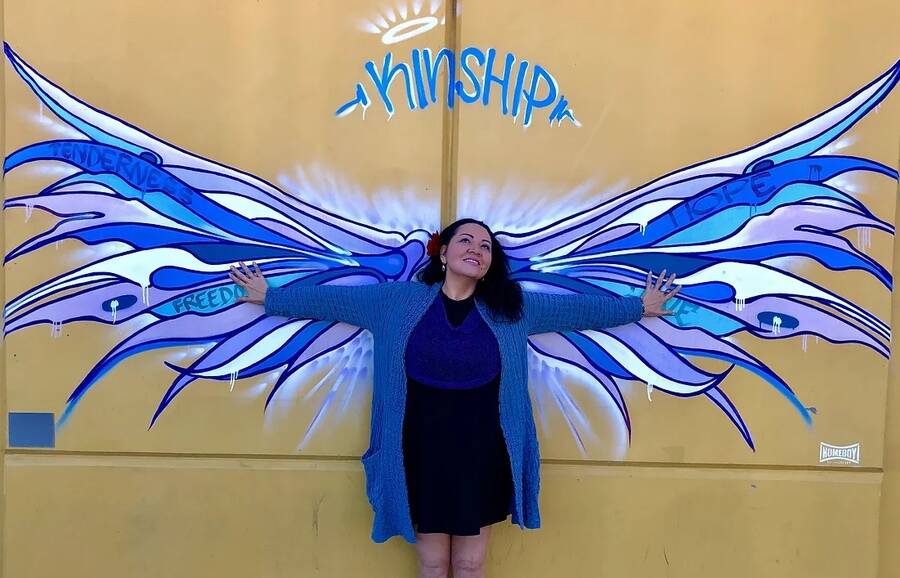
Maybe joy is enough. As I click through the old photos López sent me of her real mom and the other real women in the small Boyle Heights sewing factory, I can’t help but want a musical about them in all of their complicated, messy, specific glory. I can’t help but want a musical reflecting a politic centered on their complete liberation, that doesn’t legitimize the forces that oppress them. I can’t help but want a musical in which the Izels of our community get to be human. Real Women Have Curves isn’t quite it. But it’s one musical, by one team, in a theatre landscape woefully lacking stories by or about Mexican immigrant women. It can’t possibly do everything I ask of it. And it’s not the responsibility of this team of (mostly) Latiné creators to create a narrative complex enough to dismantle the stereotypical tropes that harm our community.
Regardless, there’s an undeniable magic in the making—and endurance—of a modern myth. It’s remarkable that the stories of women López knew in a factory 30 years ago live on at all.
“I didn’t end up in a sewing factory, but I carry the stories of these women,” López told me. She’s carried them across the country to Cambridge. Where to next?
Citlali Pizarro (she/her) is a writer, producer, and theatre artist based in New York City. She currently works in producing at the Public Theater.

